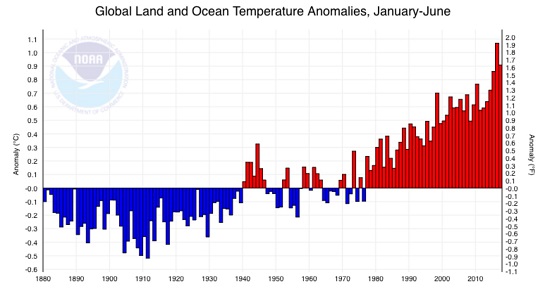
Story of the Week... Toon of the Week... Video of the Week... Coming Soon on SkS... Poster of the Week... Climate Feedback Reviews... SkS Week in Review... 97 Hours of Consensus...
2017 is so unexpectedly warm it is freaking out climate scientists
"Extremely remarkable" 2017 heads toward record for hottest year without an El Niño episode.

January–June 2017 global surface temperatures (compared to the 20th century average) in Degrees Celsius. CREDIT: NOAA
Normally, the hottest years on record occur when the underlying human-caused global warming trend gets a temporary boost from an El Niño’s enhanced warming in the tropical Pacific.
So it’s been a surprise to climate scientists that 2017 has been so remarkably warm?—?because the last El Niño ended a year ago. The National Oceanic and Atmospheric Administration (NOAA) reported Tuesday that the first half of 2017 was the second-warmest January-June on record for Earth, topped only by 2016, which was boosted by one of the biggest El Niños on record.
“As if it wasn’t shocking enough to see three consecutive record-breaking years, in 2014, 2015, and 2016, for the first time on record,” leading climatologist Michael Mann wrote in an email to ThinkProgress, “we’re now seeing near-record temperatures even in the absence of the El Nino ‘assist’ that the previous record year benefited from.”
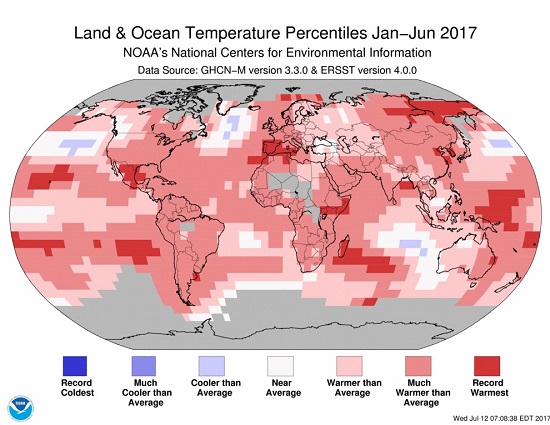
How January-June temperatures globally rank compared to the 20th century average. CREDIT: NOAA
NOAA climatologist Ahira Sanchez-Lugo told Climate Central, “After the decline of the strong El Niño, I was expecting the values to drop a bit…. This year has been extremely remarkable.”
Usually we see global records in years when the short-term El Niño warming adds to the long-term global warming trend (see chart below). As NOAA noted in its March report, without an El Niño, no month before March 2017 had ever exceeded the “normal” temperature (the 1981–2010 average) by a full 1.8°F (1.0°C).
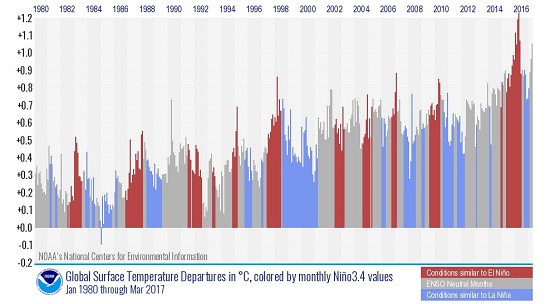
Global monthly temperature departures (from 1981–2010 average) color-coded by whether the Pacific was experiencing an El Niño (red), a La Niña (blue) or neutral conditions (gray). CREDIT: NOAA
This matters because when a month?—?or six-month period?—?sees record high global temperatures in the absence of an El Niño, that is a sign the underlying global warming trend is stronger than ever. The latest NOAA report is “a reminder that climate change has not, despite the insistence of climate contrarians ‘paused’ or even slowed down,” Mann said.
Bottom line: Human-caused global warming continues at a dangerous pace, and only human action to slash carbon pollution can stop it.
2017 is so unexpectedly warm it is freaking out climate scientists by Joe Romm, Think Progress, July 19, 2017

Climate change is real, case closed. But there's still a lot we don't understand about it, and the more we know the better chance we have to slow it down. One still-unknown factor: How might clouds play a part? There's a small hope that they could buy us some time to fix things ... or they could make global warming worse. Climate scientist Kate Marvel takes us through the science of clouds and what it might take for Earth to break its own fever.
Filmed at April 2017 at TED2017
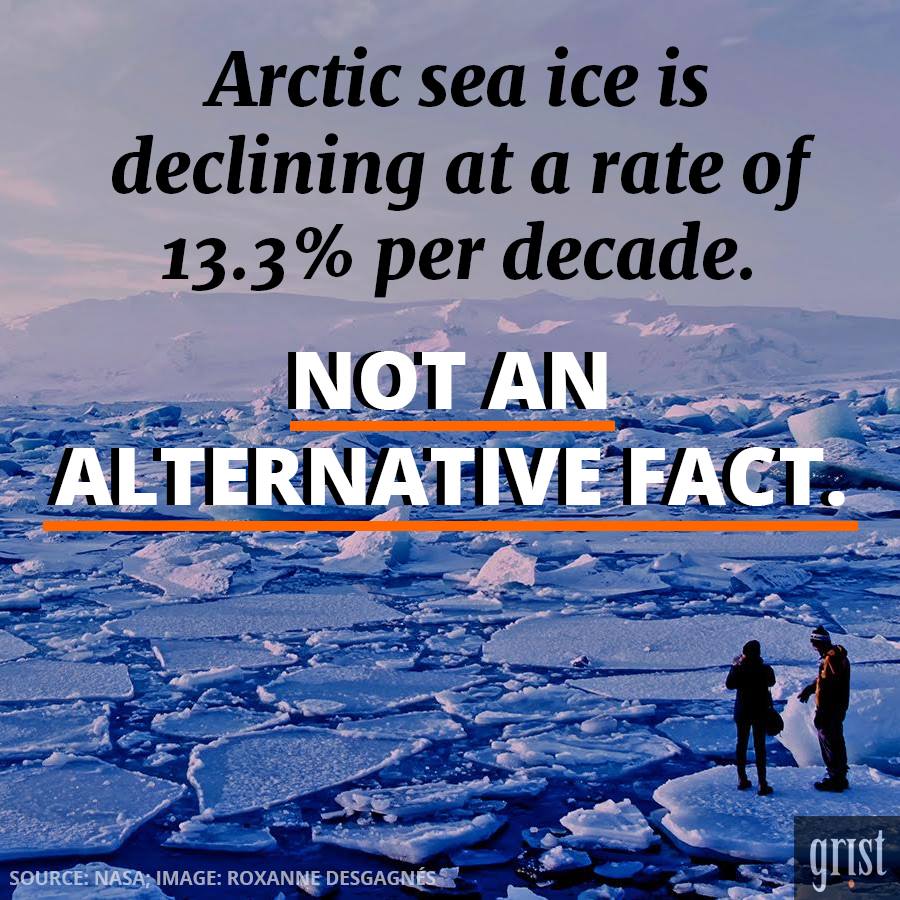
Climate Feedback asked its network of scientists to review the article, The Uninhabitable Earth by David Wallace-Wells, New York Magazine, July 9, 2017
Seventeen scientists analyzed the article and estimated its overall scientific credibility to be ‘low’.
A majority of reviewers tagged the article as: Alarmist, Imprecise/Unclear, Misleading.
Review Summary
New York Magazine published an article by David Wallace-Wells detailing the potential impacts of climate change if no action is taken to reduce greenhouse gas emissions. Much of the article explores “worst case” scenarios of change in the climate system and the resulting impacts on human populations.
Scientists reviewed the article to determine whether the descriptions of those scenarios accurately reflect the state of scientific knowledge. The New York Magazine article has triggered a number of responses debating the merits of the decision to focus on worst case scenarios, but our review simply addresses the scientific accuracy of the article.
The reviewers found that some statements in this complex article do misrepresent research on the topic, and some others lack the necessary context to be clearly understood by the reader. Many other explanations in the article are correct, but readers are likely left with an overall conclusion that is exaggerated compared to our best scientific understanding.
See all the scientists’ annotations in context.
Update (15 July 2017): New York Magazine has published an annotated version of its article indicating sourcing, which also incorporates several edits based on scientists’ comments. Read more
Update (13 July 2017): The analysis has been updated to include several comments received just after the time of publication. The main conclusion of the analysis is unchanged.
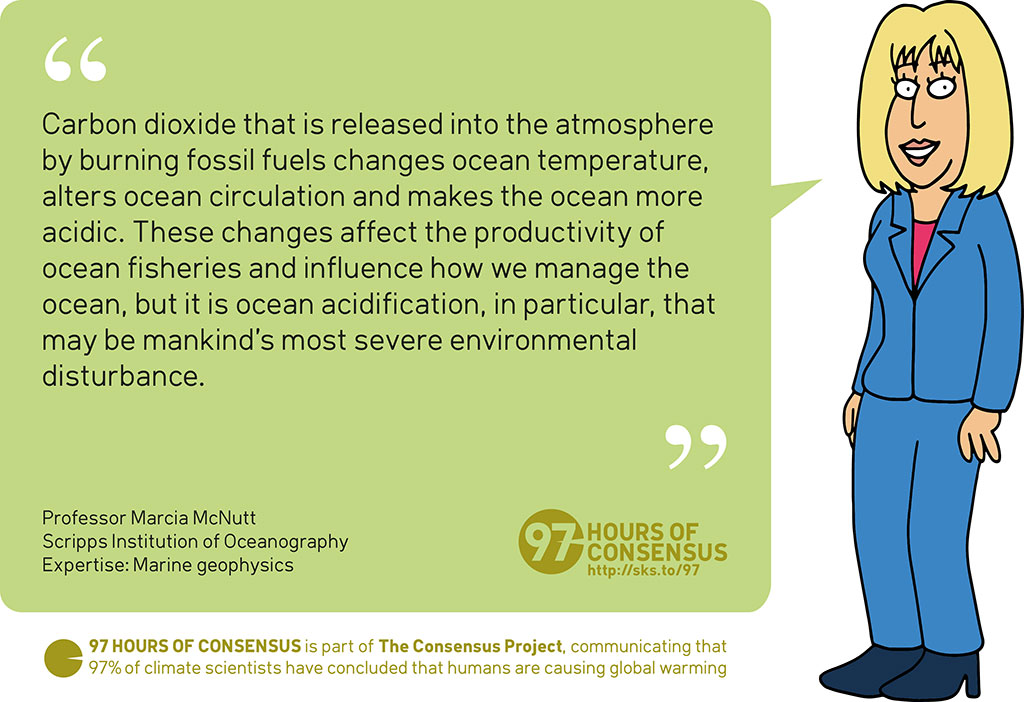
Marcia McNutt's bio page and quote source.
High resolution JPEG (1024 pixels wide)
Posted by John Hartz on Sunday, 23 July, 2017
 |
The Skeptical Science website by Skeptical Science is licensed under a Creative Commons Attribution 3.0 Unported License. |